Laden und Entladen von Kurzwaffen stellt eine der grundlegenden Funktionsabläufe im Schusswaffenumgang dar. So simpel und einfach dies erscheint, so umständlich und risikobehaftet werden diese Abläufe zumeist dargestellt. In bestimmten Kreisen scheint es meist so, als wären Ladetätigkeiten etwas, das man mehrere Semester studieren müsste, um ein angebliches Risiko überschaubar zu halten.
In diesem Artikel soll es also darum gehen, auf die möglichst einfachste Art Munition in die Waffe und wieder heraus zu bringen und dabei mit dem ein oder anderen Missverständnis aufzuräumen. Also legen wir los!
Arbeiten im Arbeitsbereich
Im Teil 6 bin ich ja bereits ausführlich auf den Arbeitsbereich und seine Funktion eingegangen und möchte daher hier nur noch einmal kurz auf die wichtigsten Dinge für die Ladetätigkeiten eingehen. Der Arbeitsbereich bezeichnet einen kugelförmigen Raum von ca. 60cm Durchmesser vor Kopf und Brust des Schützen/ der Schützin. In diesem Bereich können Manipulationen an einer Waffe schnell, sicher und effektiv ausgeführt werden. Dabei ist es wichtig, möglichst natürliche Bewegungsabläufe zu vollziehen. Die Abläufe sollen im Sehfeld ablaufen und Haltungen nicht unnötig verkrampft sein. Bewegungen sollen in geraden Linien erfolgen und am wichtigsten ist: Man muss sehen, was man macht!
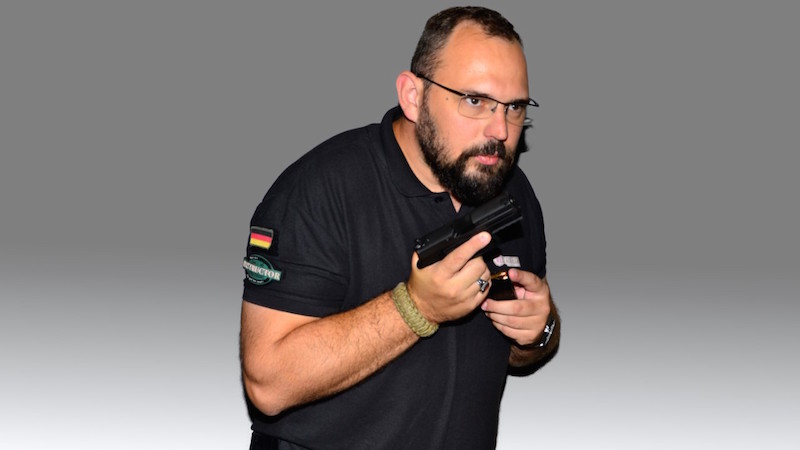 Verdammt, schon wieder Nachladen: Verkrampfte Haltung.
Verdammt, schon wieder Nachladen: Verkrampfte Haltung.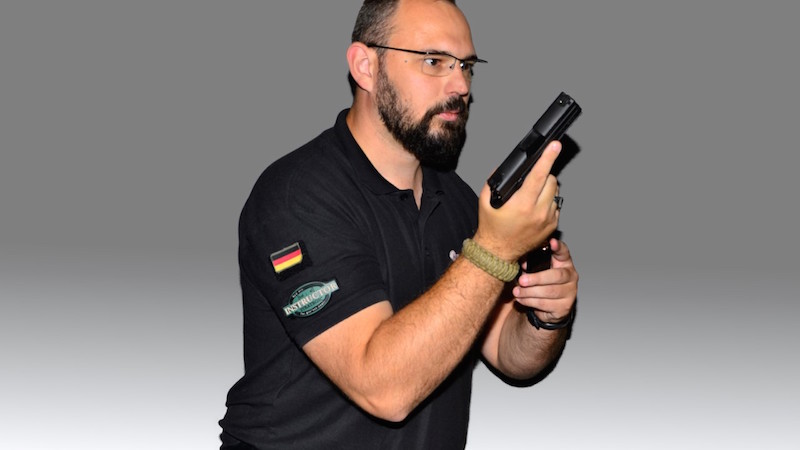
Korrekte Haltung beim Nachladen.
Auch wenn man häufig hört, der Arbeitsbereich würde im sportlichen Bereich zu Disqualifikationen führen, so versichere ich, dass dies nicht korrekt ist. Je nach Sportordnung und Disziplin muss man ggf. auf die Abweichung der Mündung von der direkten Schussrichtung achten, jedoch ist der Arbeitsbereich selber IMMER auch sportlich zugelassen. Da ein Mündungsbewusstsein aber eh essentiell für jeden Schützen /jede Schützin ist, ist die Frage nach der korrekten Haltung der Waffe ja eh rein akademisch, soll aber trotzdem für Pistole du Revolver kurz betrachtet werden.
Mündungsbewusstsein
Während bei Pistolen i.d.R. die Mündung bei Ladetätigkeiten eher nach oben (siehe Bild) orientiert ist, wechselt bei Ladetätigkeiten mit dem Revolver die Orientierung während der Abläufe.

Das Mündungsbewusstsein ist elementarer Bestandteil jeden Schusswaffenhandlings und sollte daher im Mittelpunkt einer grundlegenden Sensibilisierung stehen. Damit ist jedoch nicht gemeint, dass man mit Unmengen an Regelungen, Vorgaben und Restriktionen die Verantwortung vom Schützen nimmt, sondern das genaue Gegenteil. Man selber ist als Schütze einzig und allein für die Waffe verantwortlich; eben auch dafür, dass die Mündung nur dahin gerichtet wird, wo sie hin soll.
Die Auswertung von Unfallstatistiken im Umgang mit Schusswaffen in Verbindung mit einer abgeänderten Ausbildung seit 2009 ergab, dass alleine die Rückgabe von Verantwortung an den/die Einzelne(n) zu einem signifikanten Rückgang von Schießunfällen (41%), ungewollten Schussauslösungen (84%) und gefährdendem Verhalten (76%) führte. Dies wird darauf zurück geführt, dass die „Fremdsteuerung“ durch Aufsichten und Range Officer die Verantwortung vom Schützen weg nimmt und daher auch kein eigenes Schuldbewusstsein bei Fehlverhalten entsteht. Durch die Eigenverantwortung findet im Vorfeld bereits eine Sensibilisierung statt, welche Fehlern vorbeugt und eine positive Entwicklung der eigenen Fertigkeiten begünstigt.
Man kann dies mit dem Autofahren vergleichen. Man stelle sich vor, man müsste immer mit einem Fahrlehrer ins Auto steigen, der einem jeden einzelnen Schritt ansagt und einen aus dem Auto wirft, wenn man etwas falsch macht.
Mündungsbewusstsein ist also der erste Schritt auf dem Weg zum eigenverantwortlichen Handeln mit Schusswaffen.
Pistolen Laden
Pistolen werden i.d.R. über Magazine geladen. Das vereinfacht so Einiges in Bezug auf die Ladetätigkeiten, da Patronen nicht einzeln zugeführt werden müssen, wie bei Revolvern.
Es empfiehlt sich, auch die Ladetätigkeiten grundsätzlich in einen kompletten Bewegungsablauf einzubauen, um so die zusammenhängenden Abläufe zu festigen; z.B. zum Fertigladen den Ablauf bis zum Anschlag durchzuführen und von dort die Waffe in den Arbeitsbereich zu bringen. Somit sind diese Abläufe einmal mehr geübt.
Im Arbeitsbereich wird die Waffe – unter Berücksichtigung der jeweiligen Reglements – so eingedreht, dass Mündung und Magazinschacht sich im Sehfeld befinden und auch tatsächlich sichtbar sind. Die Arbeitshand wird parallel dazu gelöst und greift nach dem benötigten Magazin; beim Fertigladen das langsamste Magazin (siehe auch Teil 11- Ausrüstung).
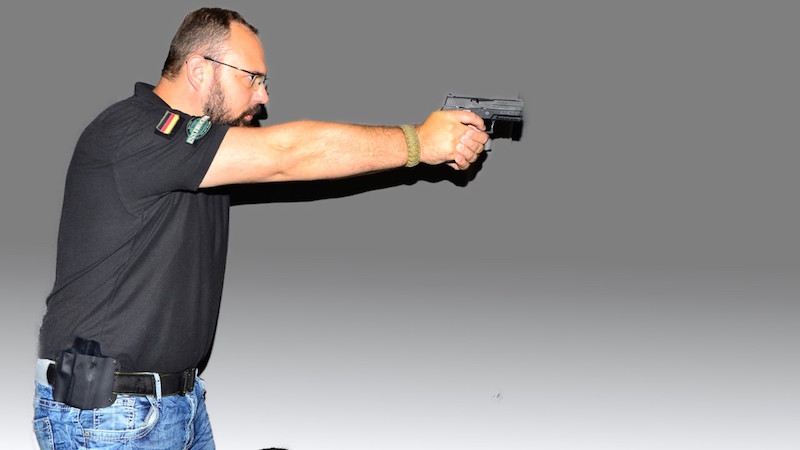
Im Anschluss wechselt der Fokus vom Zielbereich auf den Magazinschacht und das Magazin wird in einer Bewegung in die Waffe eingesetzt und eingerastet.
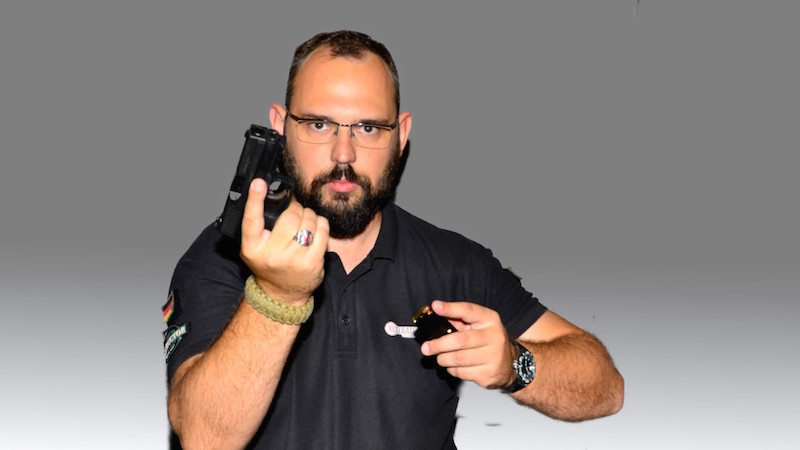
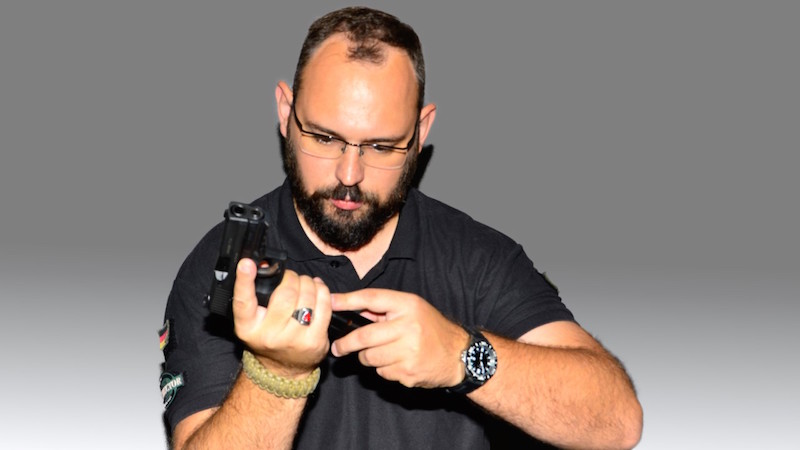
Magazinwechsel
Auch der Magazinwechsel wird im Arbeitsbereich durchgeführt. Im Gegensatz zum Nachladen wird der Magazinwechsel immer dann durchgeführt, wenn ein volles Magazin in der Waffe zweckmäßig ist, um Verzögerungen durch ein Nachladen zu vermeiden. Der Magazinwechsel wird auch als sog. tactical relaod bezeichnet und erfolgt nicht unter großem Zeitdruck.
Die Arbeitshand greift dabei zunächst das neue Magazin (langsames Magazin), welches dann im Arbeitsbereich zur Waffe geführt wird.
Erst dann wird das alte Magazin aus der Waffe entnommen und das neue Magazin eingesetzt. Dabei ist darauf zu achten, dass der Abzugsfinger nicht auf dem Abzug liegt und, sofern möglich, die Waffe gesichert wird. Man muss dabei beachten, dass sich beim Magazinwechsel noch eine Patrone im Patronenlager befindet.
Für den Magazinwechsel bieten sich zwei Möglichkeiten der Magazinhaltung an:
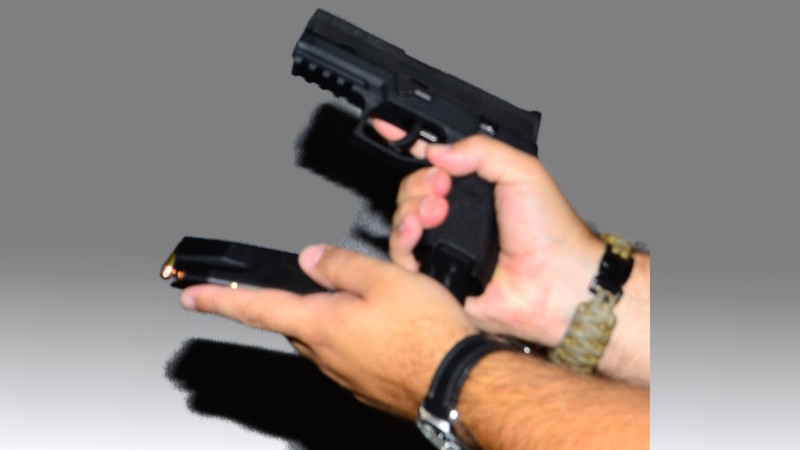
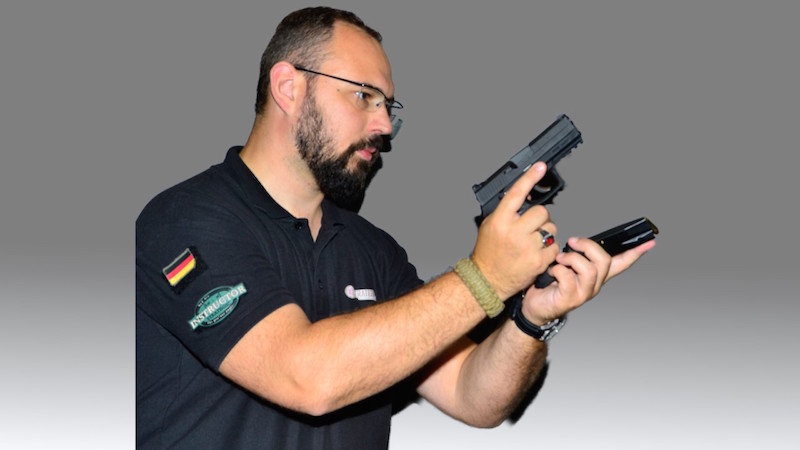
- L- Haltung (o.)
- Parallelhaltung (u.)
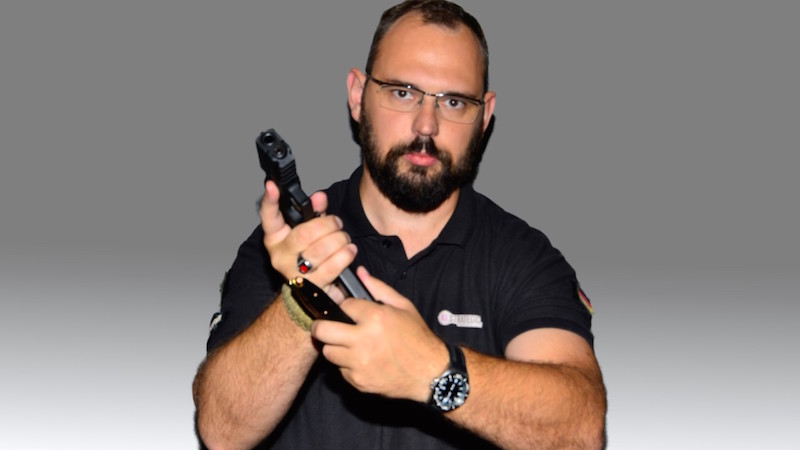
Die Zeit ohne Magazin sollte beim Magazinwechsel so kurz wie möglich gehalten werden. Am Wichtigsten jedoch ist es, das alte Magazin wieder zu verstauen und nicht die Munition einfach fallen zu lassen!
Zum Abschluss des Magazinwechsels kann optional eine Ladekontrolle durchgeführt werden. Dabei wird der Verschluss ca. 1cm kontrolliert zurück geführt und geprüft, dass sich eine Patrone im Patronenlager befindet (brass check). Dies erfordert ein wenig Übung, um keine Störungen zu produzieren. Wie bei allen Tätigkeiten sollte dabei darauf verzichtet werden, den Verschluss wie ein rohes Ei mit zwei Fingern zu greifen, sondern volle Kontrolle mit der ganzen Hand auszuüben. Das Sicherstellen der Verschlussverriegelung sollte als Abschluss der Ladekontrolle immer durchgeführt werden. Dazu wird der Verschluss nach dem vorschnellen lassen noch einmal mit einem leichten Schlag auf die Rückseite bedacht, um die Verriegelung sicher zu stellen. Dies funktioniert im Übrigen bei allen Arten von Pistolen.
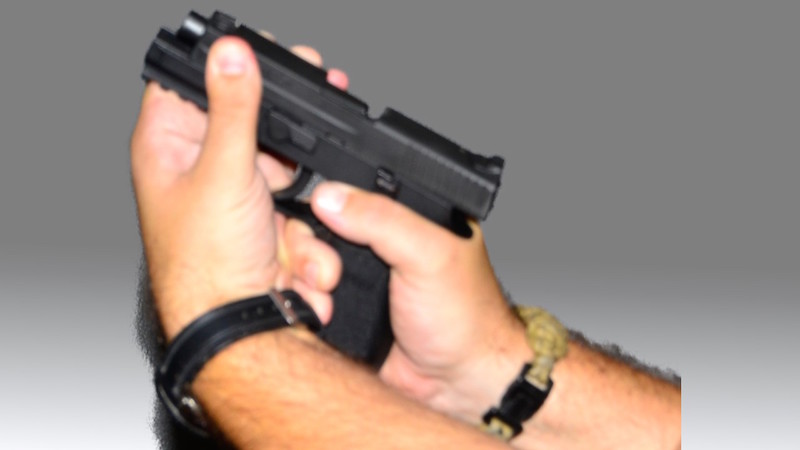
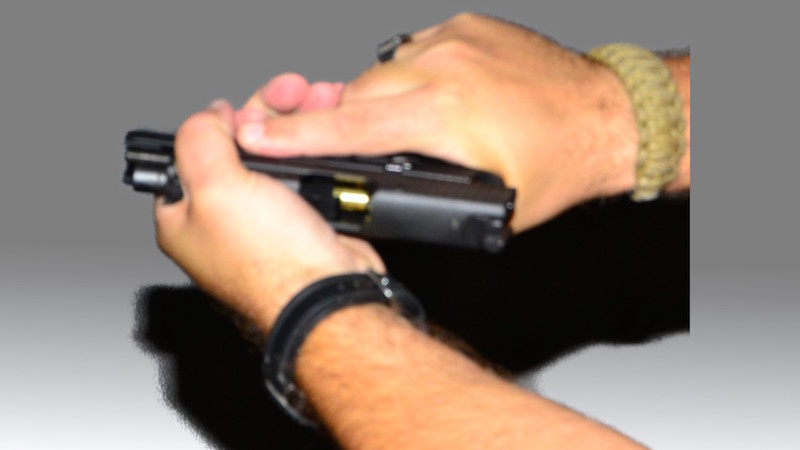
Nachladen
Im Gegensatz zum Magazinwechsel erfolgt das Nachladen bei Pistolen immer dann, wenn das Magazin leer geschossen ist und der Verschluss in der hinteren Position dadurch arretiert. In diesen Fällen muss so schnell wie möglich neue Munition in die Waffe gebracht werden. Aus diesem Grund wird diese Technik auch als Slidelock reload oder speed reload bezeichnet.
Aus dem Anschlag wird die Waffe eingedreht in den Arbeitsbereich gebracht. Parallel dazu löst sich die Arbeitshand vom Griffstück und greift nach dem „schnellen Magazin“ ( siehe Teil 11- Ausrüstung), während mit der Schusshand das leere Magazin aus der Waffe ausgeworfen wird. Ein sichern der Waffe ist hierbei nicht nötig, da die Waffe nicht schussbereit ist. Das ausgeworfene Magazin hat in diesem Moment keinen Mehrwert mehr für den Ablauf und benötigt daher auch keine weitere Aufmerksamkeit.
Im Arbeitsbereich angekommen wird das neue Magazin zügig in Richtung Magazinschacht geführt, wobei der Blick noch immer im Zielbereich fokussiert ist. Erst im kritischen Moment – das Zusammenbringen von Magazin und Waffe – wechselt der Fokus auf den Magazinschacht, um ein zügiges Einführen zu gewährleisten.
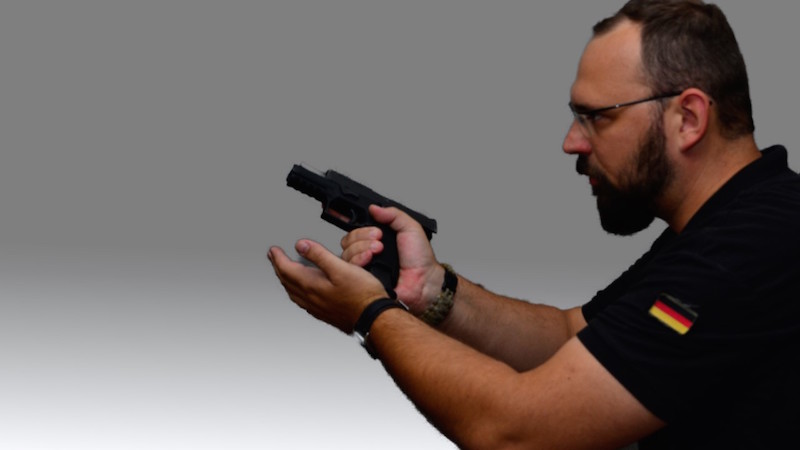
Das Magazin wird mit einer Bewegung eingesetzt und eingerastet. Bei machen Modellen kann die Arretierung des Verschluss bereits durch das Einsetzen gelöst werden, indem die Kraft nicht senkrecht auf den Magazinboden ausgeübt wird, sondern in einem 45° Winkel nach Vorne. Dies erfordert jedoch Übung und funktioniert nicht bei allen Modellen!
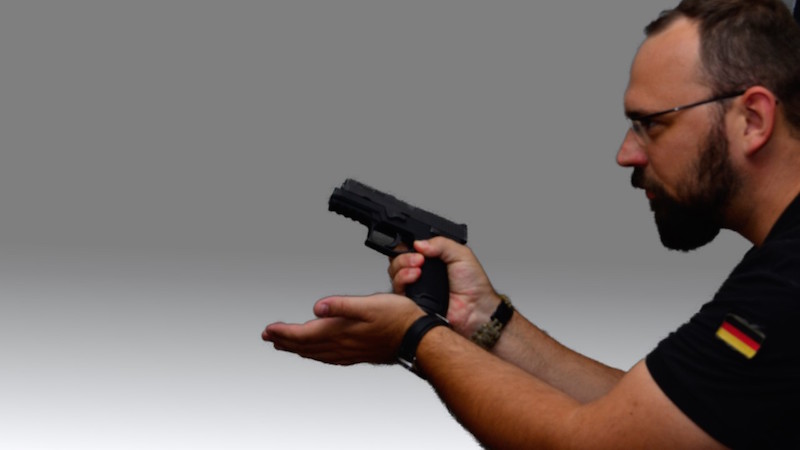
Die Arretierung des Verschlusses kann auf zwei Arten gelöst werden. Zum Einen durch betätigen des Verschlussfanghebels, zum Anderen durch Lösen des Verschlusses.
Stressresistentes Arbeiten bedeutet immer grobmotorisch zu agieren. Im Stress einen kleinen (oder auch ggf. vergrößerten) Verschlussfanghebel zu drücken kann sich ggf. als schwierig bis nicht sofort realisierbar erweisen. Definitiv Umsetzbar ist jedoch die Methode, den Verschluss durch Zurückziehen zu entriegeln und vorschnellen zu lassen.
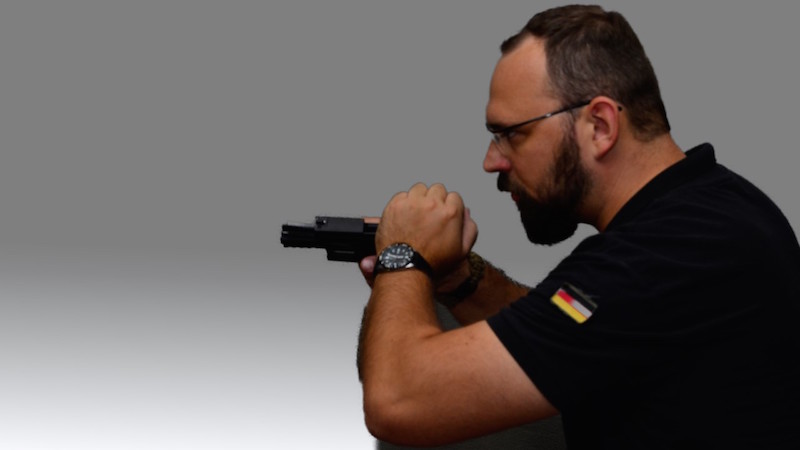
Es versteht sich von selbst, dass eine Ladekontrolle beim Nachladen wenig Sinn ergibt. Da sich die Waffe nach dem Entriegeln des Verschlusses bereits in der Vorwärtsbewegung befindet, kann hier gleich wieder der Anschlag etabliert werden und weitere Schussabgaben erfolgen.
Entladen Pistole
In Bezug auf das Entladen von Pistolen möchte man manchmal gar nicht glauben, was für umständliche Praktiken und gefährliche Kunststückchen sich Manche ausdenken, um die Munition aus der Waffe zu holen.
Grundlegend erfolgt das Entladen in vier Phasen:
- Sichern der Waffe
- Entnehmen des Magazins
- Entnehmen der zugeführten Patrone
- Kontrolle der Sicherheit
So wie alle Manipulationen erfolgt auch das Entladen im Arbeitsbereich. Nach dem lösen des Abzugsfingers vom Abzug wird die Waffe im Arbeitsbereich eingedreht und das Magazin entnommen. Zur besseren Kontrolle und um unnötiges Rumwerkeln zu unterbinden, kann das Magazin zwischen Ringfinger und kleinem Finger der Schusshand gehalten werden, während die Waffe weiter entladen wird. So kann sichergestellt werden, dass die Waffe erst vollständig entladen und sicher ist, bevor weitere Arbeiten an der Ausrüstung erfolgen (Verstauen des entnommenen Magazin, usw.).
Als zweiter Schritt wird die Waffe mit Mündung in Zielrichtung um die Rohrseelenachse auf die rechte Seite gekippt (Auswurföffnung nach Unten weisend). Die Arbeitshand greift über den Verschluss (Achtung: nicht sweepen!) und deckt die Auswurföffnung ab.
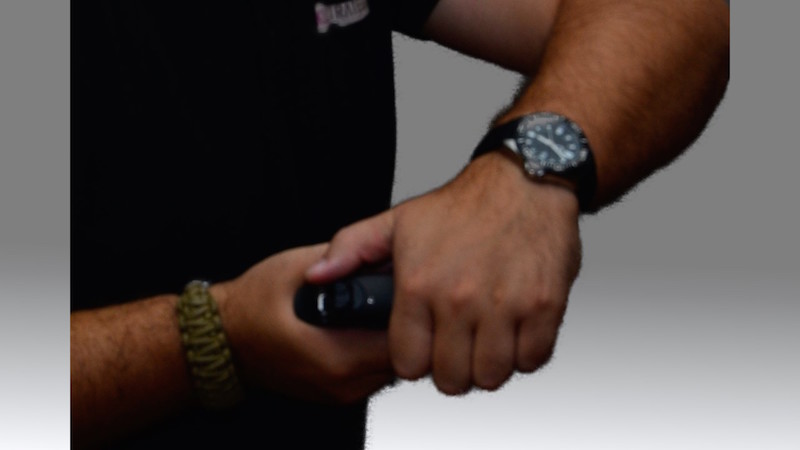
Der Verschluss wird zurück geführt und mit dem Verschlussfanghebel arretiert. Die zugeführte Patrone fällt dabei automatisch in die Arbeitshand. Nun kann die Waffe zurück gedreht werden und auf Sicherheit überprüft werden.
Die Pistole ist sicher und einfach entladen, ohne durch umständliche Verrenkungen, gefährliche Kunststückchen oder zu wenig Hände zum gleichzeitigen Arbeiten sich und/oder andere zu gefährden.
Laden Revolver
Im Gegensatz zur Pistole muss bei Revolvern jede Trommelbohrung mit einer einzelnen Patrone versehen werden. Um dies einfach zu gestalten gibt es diverse Hilfsmittel, die das Zuführen mehrerer Patronen auf einmal ermöglichen. Nichts desto trotz bleibt das Grundproblem, dass immer genau eine Patrone in genau eine Bohrung geladen werden muss.
Wie auch bei der Pistole kann man den Ladevorgang dazu nutzen, den kompletten Schießablauf einmal trocken durchzuführen, um den Trainingseffekt zu nutzen.
Beim Zurückgehen in den Arbeitsbereich kann hier nun bereits der erste Bewegungsablauf des Nachladens geübt werden, indem die Arbeitshand, nach Lösen des Abzugsfingers die Trommelarretierung löst, die Trommel ausschwenkt und die Auswurfstange betätigt.

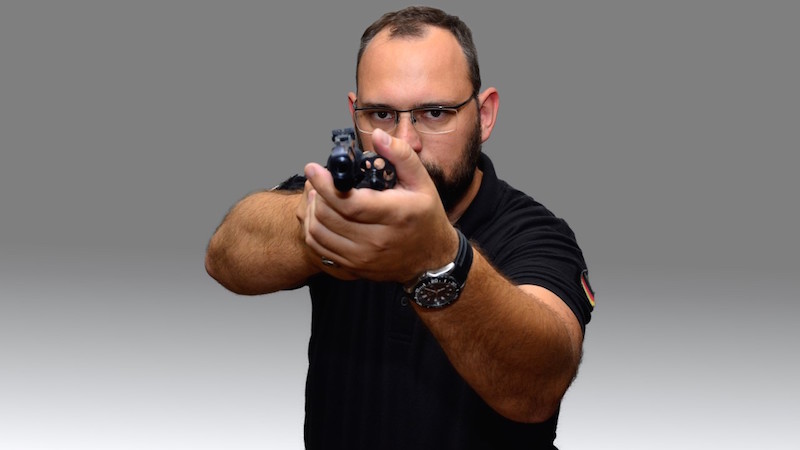 Dabei wird der Revolver mit der Mündung leicht angehoben, um die Schwerkraft bei der Auswerfbewegung zu nutzen.
Dabei wird der Revolver mit der Mündung leicht angehoben, um die Schwerkraft bei der Auswerfbewegung zu nutzen.
Somit ist hier bereits sicher gestellt, dass keine Patronen in der Trommel verbleiben. Trotzdem sollte im weiteren Verlauf ein Blick in Trommelbohrungen und Lauf erfolgen, um die Sicherheit zu gewährleisten.
Dieser Blick ergibt sich quasi von selbst, wenn die Waffe in der weiteren Bewegung zum Laden mit der Mündung von der oberen in die untere Orientierung wechselt. Dabei passiert sie die Horizontale, was es ermöglicht, Trommel und Lauf mit einem Blick zu prüfen.
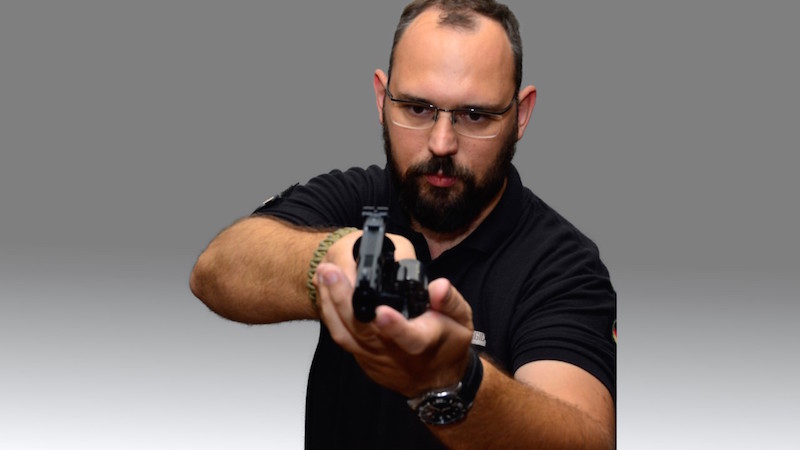
Der Orientierungswechsel der Mündung ist nötig, um im Weiteren Verlauf des Ladens die Schwerkraft zu nutzen und sich den Ladevorgang einfacher zu gestalten.
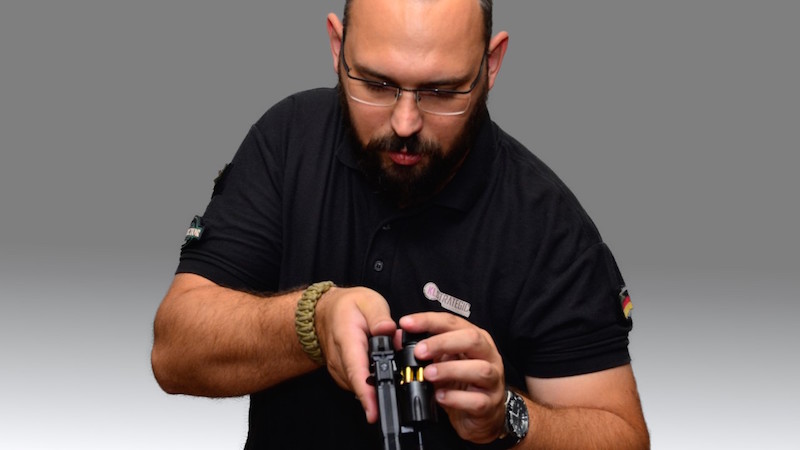
Der Revolver wird mit der Mündung nach Unten orientiert an das untere Ende des Arbeitsbereiches bewegt, ohne dabei die Körperhaltung unnötig zu verändern. Ein Einrollen des Oberkörpers ist hier völlig unnötig.
Die Arbeitshand greift nach den langsamen Patronen/ Speedloader (siehe Teil 11- Ausrüstung) und bringt diese zur Trommel. Für den Moment des Zuführend der Patronen wechselt der Fokus vom Vorfeld auf die Trommel, um sichere Bewegungen zu gewährleisten.
Nach dem Zuführen aller Patronen in die Trommelbohrungen wechselt der Fokus wieder auf das Vorfeld und der Revolver wird mit dem Handballen der Arbeitshand stressresistent geschlossen, während die Waffe mit der Mündung noch nach Unten orientiert ist. Somit wird ein herausrutschen oder Herausfallen einzelner Patronen und damit eine Störung des Ablaufs verhindert.

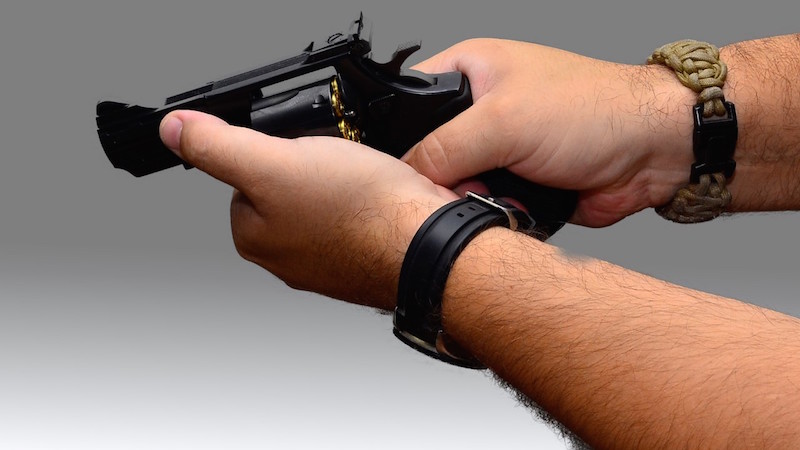
„Magazinwechsel“ und Nachladen Revolver
Das Nachladen eines Revolvers entspricht im Ablauf dem o.g. Ablauf des Ladens. Nach dem Schließen der Trommel befindet sich die Arbeitshand bereits wieder an der Waffe und so kann der Griff sofort wieder Etabliert, der Anschlag eingenommen und eine weitere Schussabgabe eingeleitet werden.
Da ein Revolver Naturgemäß nicht über ein Magazin, wie eine Pistole, verfügt, ist der Begriff Magazinwechsel hier als Synonym für das Austauschen leerer Hülsen gegen Patronen zu sehen.
Wie beim Magazinwechsel bei der Pistole erfolgt dies, wenn die Zeit dafür gegeben ist.
Nach dem Sichern der Waffe wird diese in den Arbeitsbereich gebracht und dabei die Trommel geöffnet. Dabei ist darauf zu achten, dass die Mündung gleich nach unten orientiert wird, um ein herausfallen der Patronen und Hülsen zu verhindern. Am unteren Bereich des Arbeitsbereiches werden leere Hülsen (erkennbar am angeschlagenen Zündhütchen/ Patronenboden) einzeln entnommen. Danach werden die freien Bohrungen mit Patronen bestückt, die Trommel geschlossen und die Waffe für den nächsten Ablauf in Position gebracht.
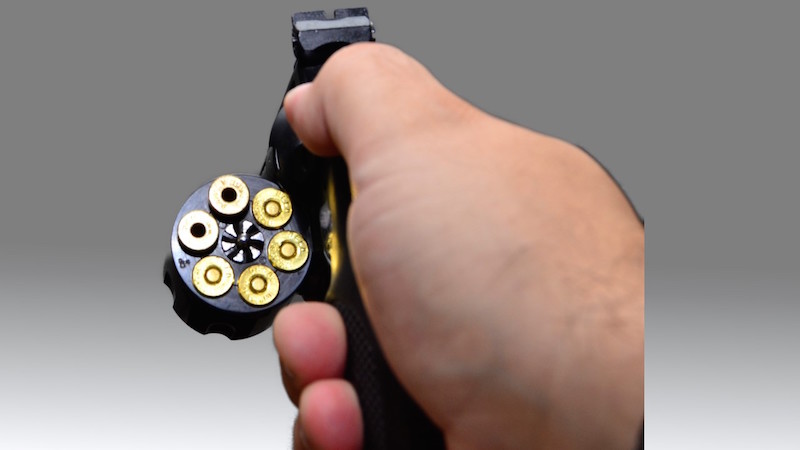
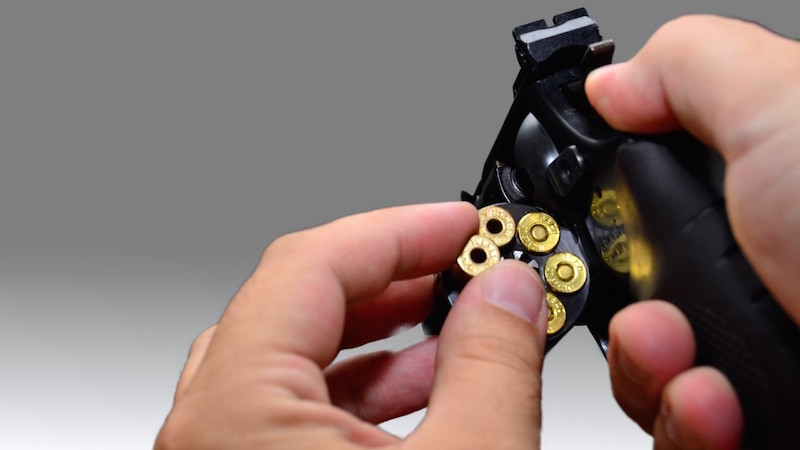
Es ist dabei darauf zu achten, dass alle Arbeiten mit der Arbeitshand durchgeführt werden, während die Schusshand grundsätzlich nur die Waffe führt.
Entladen Revolver
Das Entladen eines Revolvers erfolgt ähnlich dem Ladevorgang. Einziger Unterschied ist, dass die Patronen und ggf. leeren Hülsen von der Arbeitshand aufgefangen werden bzw. im Arbeitsbereich einzeln entnommen werden. Als Abschluss bleibt die Trommel geöffnet und die Sicherheit wird mit einem Block in Trommelbohrungen und Lauf kontrolliert.
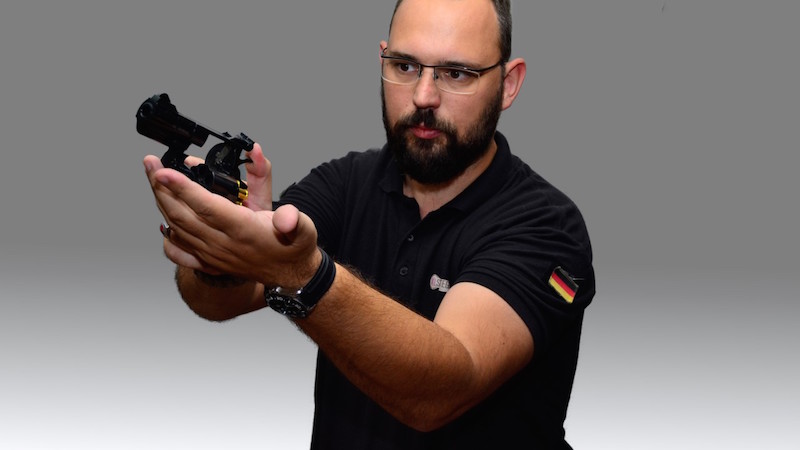
Egal ob Pistole oder Revolver, die Ladetätigkeiten haben immer nur ein Ziel: Munition die Waffe, oder aus ihr heraus zu bekommen. Ein wenig verantwortliches Handeln bringt dabei ein Höchstmaß an Sicherheit mit sich und man stellt fest, dass es keiner unnötigen Verrenkungen oder gar Kunststückchen wie das Auswerfen und aus der Luft fangen von Patronen bedarf, um Sicherheit im Umgang mit der Schusswaffe auch nach außen zu zeigen.
In diesem Sinne – train as you fightKhi Pa
KL STRATEGIC im INTERNET: http://kl-strategic.com
KL STRATEGIC auf FACEBOOK: www.facebook.com/KL-STRATEGIC
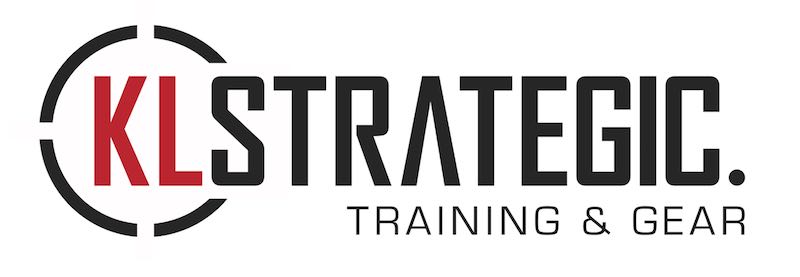

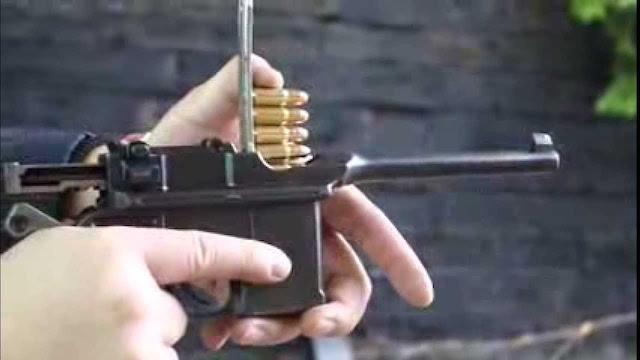

 Verdammt, schon wieder Nachladen: Verkrampfte Haltung.
Verdammt, schon wieder Nachladen: Verkrampfte Haltung.























